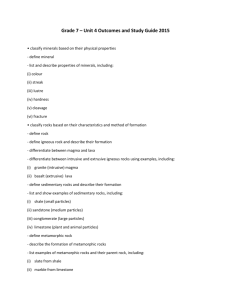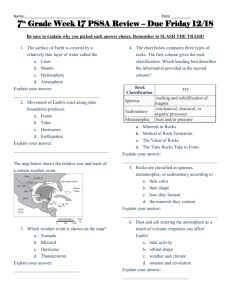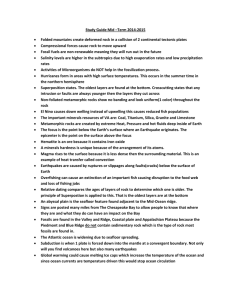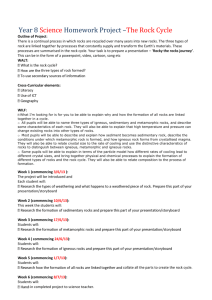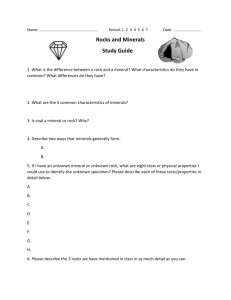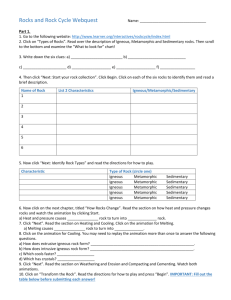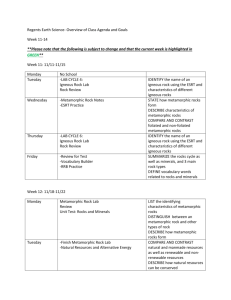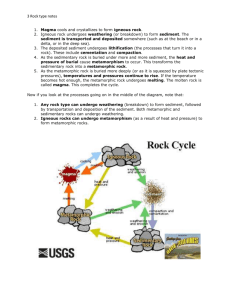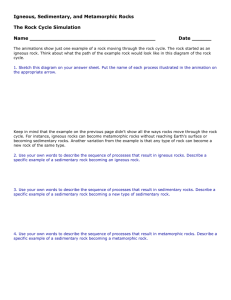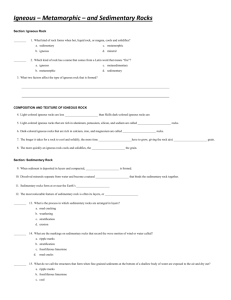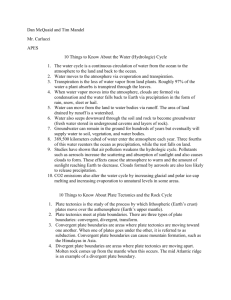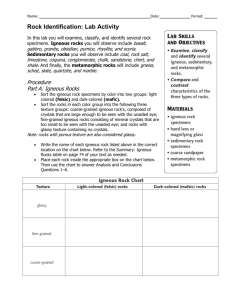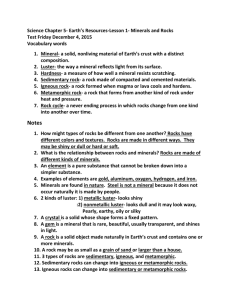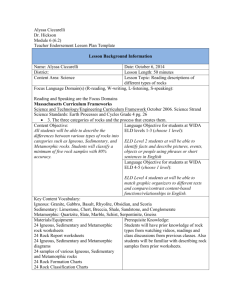7th Grade Semester Final Study Guide
advertisement
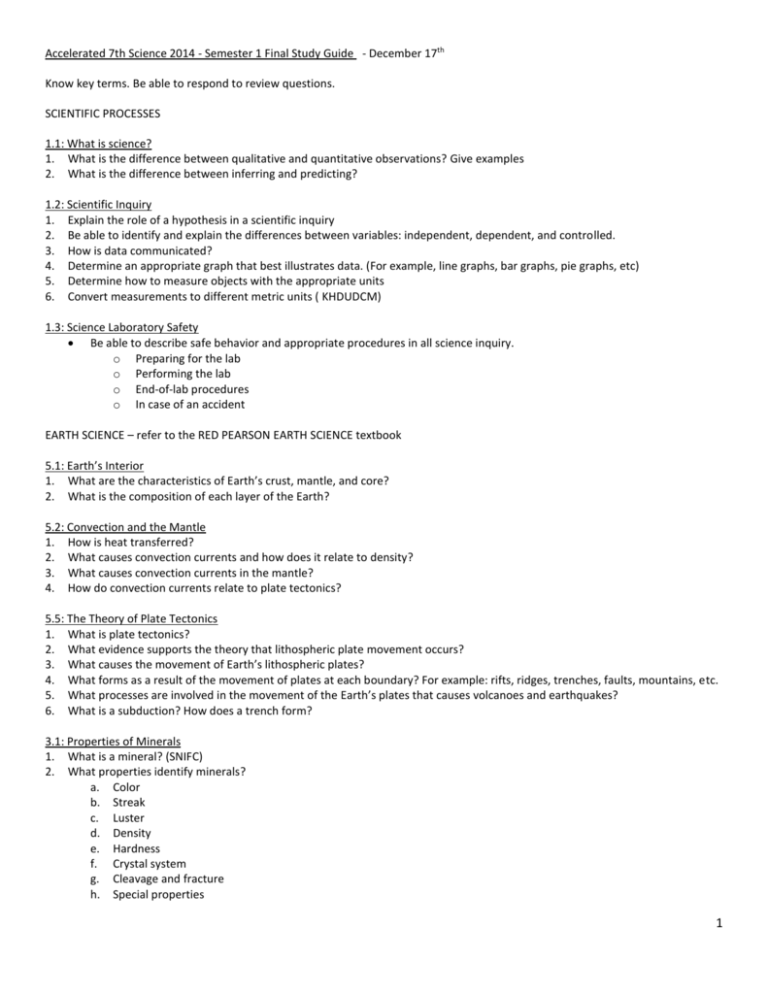
Accelerated 7th Science 2014 - Semester 1 Final Study Guide - December 17th Know key terms. Be able to respond to review questions. SCIENTIFIC PROCESSES 1.1: What is science? 1. What is the difference between qualitative and quantitative observations? Give examples 2. What is the difference between inferring and predicting? 1.2: Scientific Inquiry 1. Explain the role of a hypothesis in a scientific inquiry 2. Be able to identify and explain the differences between variables: independent, dependent, and controlled. 3. How is data communicated? 4. Determine an appropriate graph that best illustrates data. (For example, line graphs, bar graphs, pie graphs, etc) 5. Determine how to measure objects with the appropriate units 6. Convert measurements to different metric units ( KHDUDCM) 1.3: Science Laboratory Safety Be able to describe safe behavior and appropriate procedures in all science inquiry. o Preparing for the lab o Performing the lab o End-of-lab procedures o In case of an accident EARTH SCIENCE – refer to the RED PEARSON EARTH SCIENCE textbook 5.1: Earth’s Interior 1. What are the characteristics of Earth’s crust, mantle, and core? 2. What is the composition of each layer of the Earth? 5.2: Convection and the Mantle 1. How is heat transferred? 2. What causes convection currents and how does it relate to density? 3. What causes convection currents in the mantle? 4. How do convection currents relate to plate tectonics? 5.5: The Theory of Plate Tectonics 1. What is plate tectonics? 2. What evidence supports the theory that lithospheric plate movement occurs? 3. What causes the movement of Earth’s lithospheric plates? 4. What forms as a result of the movement of plates at each boundary? For example: rifts, ridges, trenches, faults, mountains, etc. 5. What processes are involved in the movement of the Earth’s plates that causes volcanoes and earthquakes? 6. What is a subduction? How does a trench form? 3.1: Properties of Minerals 1. What is a mineral? (SNIFC) 2. What properties identify minerals? a. Color b. Streak c. Luster d. Density e. Hardness f. Crystal system g. Cleavage and fracture h. Special properties 1 3. 4. How are mineral’s determined using the Mohs hardness scale? Be able to read a chart and determine the identity of a mineral? 4.1: Classing Rocks 1. How are rocks identified? 2. What are the three main groups of rocks? 3. How does each type form? 4. How does the rate of cooling affect the texture of an igneous rock? a. What would the texture be of a rock that cooled quickly? Slowly? 4.2: Igneous Rocks 1. How are igneous rocks formed? 2. What characteristics are used to classify igneous rocks? 4.3: Sedimentary Rocks 1. How doe sedimentary rocks form? 2. What characteristics are used to classify sedimentary rocks? 4.5: Metamorphic Rock 1. How are metamorphic rock formed? 2. Metamorphic rock is formed from heat and pressure. Where does the heat and pressure come from? 3. What are some characteristics of metamorphic rocks? 4.6: The Rock Cycle 1. What is the rock cycle? 2. What are the possible stages in the rock cycle? 3. Know the processes that occur when a rock changes from one kind to another. For example: igneous to sedimentary or sedimentary to metamorphic. 4. What are some of the causes for weathering and erosion? (FRAPA LOWCA, WWGMA) 6.2: Earthquakes & Seismic Waves 1. What causes an earthquake? 2. How does the energy of an earthquake travel through Earth? 3. What are the scales used to measure the strength of an earthquake? 4. How do scientists locate the epicenter of an earthquake? 7.1: Volcanoes and Plate Tectonics 1. Where are most Earth’s volcanoes found? 10.1: Fossils 1. What is a fossil? 2. How does a fossil form? 10.2: Relative Dating 1. Given a certain cross section of rock, indicate which layers were deposited first to last. 2. Describe how the rock and fossil record show that environmental conditions have changed over geologic and recent time. 3. Predict the environment based on the fossil and rock record from a cross section. 2 PHYSICAL SCIENCE – refer to the BLUE PEARSON PHYSICAL SCIENCE textbook 2.1: Describing Matter 1. Classify matter in terms of elements, compounds, and mixtures. 2. Classify matter as being homogeneous or heterogeneous. 3. Investigate how the transfer of energy can affect the physical and chemical properties of matter. 4. Be able to determine physical and chemical properties of matter? (physical properties: boiling point, melting point, solubility and chemical properties: reactivity, flammability, etc.) 5. What kinds of properties are used to describe matter? 6. What are elements, and how do they relate to compounds? 7. What are the properties of a mixture? 8. What is the difference between a heterogeneous mixture and homogeneous mixture? Give examples. 9. What is the difference between an element, compound and a mixture? Give examples. 10. How are chemical bonds formed? 2.2: Measuring Matter 1. Know units for measurements of properties of matter. (For example, mass, volume, density) 2. What scientific tools are used to determine measurements of matter? For example, volume or mass. 3. Volume: define, units, and how is it calculated? a. How can the volume of an object be determined? Cube, or irregular shaped object 4. Density: define and determine how it is used to identify matter. Be able to calculate density 2.3: Changes in Matter 1. What is a physical change? Give examples 2. What is a chemical change? Give examples 3. How are physical and chemical changes in matter related to changes in energy? 4. What is the law of conservation of mass? 5. What is the difference between endothermic and exothermic change? 3.1: States of Matter 1. What are the characteristics between a solid, liquid, and a gas? 3.2: Changes of State 1. What happens to a substance during changes between solid and liquid? 2. What happens to a substance during changes between liquid and gas? 3. What happens to a substance during changes between solid and gas? 4. Are changes in state a physical or chemical property of matter? 5. How is energy related to changes of states of matter? 7.1: Understanding Solutions 1. What are the two parts of a solution? Examples 2. What is the difference between solute and solvent? 3. How does a solute affect the freezing and boiling points of a solution? 7.2: Concentration and Solubility 1. Why is solubility useful in identifying substances? 2. What factors affect solubility? 7.3 and 7.4: Describing Acids & Bases and Acids and Bases in Solution 1. What are the properties of acids and bases? Give examples 2. What does the pH of a solution tell you? 3. How are the strengths of acids and bases determined? 4. What is the pH scale and how is it read? 3

